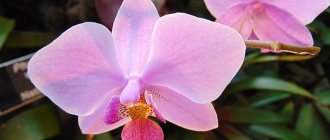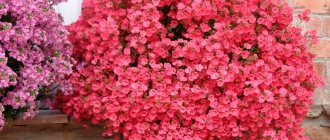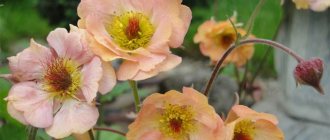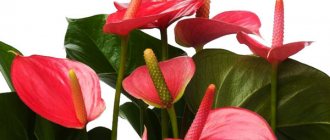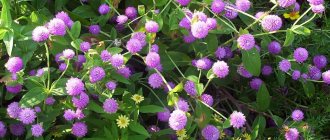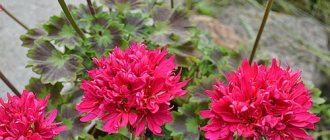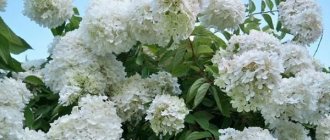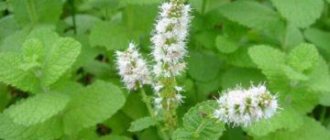Columnea is a perennial evergreen plant from the Gesneriaceae family .
The flower originated in the tropical rainforests of Central and South America. It often grows as an epiphyte, attaching itself to tree trunks, rocks and tall grasses. Fleshy, but rather fragile branches pointing upward begin to cascade down over time. Shoots 30–50 cm long are decorated with small heart-shaped leaves. Columnia grows quickly, lengthening its branches by 0.5 m per year. At the end of February - beginning of March, original bright flowers are formed on them, similar to small moths or fish. The edges of the petals are covered with a light silvery fluff.
Some species can bloom all year round. Columneya is a perennial flower, if it is not rejuvenated in time, it loses its decorative effect.
| The plant grows quickly. |
| It blooms from mid-winter to early spring with tubular red flowers. |
| The plant is grown with little difficulty. |
| Perennial. |
Popular types
There are more than 200 species of columnae, many of which remain to grow in their usual habitat.
However, some types of these flowers have long spread throughout the world and are grown as decorative indoor plants on balconies, terraces, as decorations in flower beds and gardens. One of the popular types of columns is the Carnival type. This flower has many dense small leaves, which are covered with a glossy coating and fine whitish pubescence. Carnival flowers are bright yellow, but have a burgundy edge around the edges.
Allen's column came to us from Panama. This country, which is located in the south of North America, shelters in its jungle a beautiful plant, the flowers of which are quite large (about 8 cm) and have a red-orange color. The leaves of this species are small and elliptical in shape. The shoots are creeping or hanging, which are constantly increasing in size.
Columnae Krakatoa is probably the most common type of this plant in our country. It was bred by breeders specifically for cultivation and care at home. Krakatoa was bred from Banks Columnae, whose homeland is considered to be a huge part of South and Central America. Krakatoa got its name in honor of the volcano of the same name, which, when erupting, gives out all the same colors that can be seen when Columna Krakatoa blooms. The leaves of this flower have the shape of an elongated ellipse and are painted in a rich dark green color. This plant blooms with fiery red flowers reaching a length of 10-12 cm.
Columnea blood-red is also a frequent visitor to lovers of exotic ornamental plants in our country. This flower is slightly different from its counterparts: it has larger leaves (up to 30 cm), the flowers are formed in groups and have bright red pubescence, the shoots are woody and long (up to 1.3 meters). The mountainous regions of the Antilles are considered the birthplace of the blood-red plant.
Columnae Banks has fairly long semi-lignified shoots (length reaches 1 meter). The leaves are covered with a waxy coating, the underside has large red spots. The flowers are tubular, orange-red-yellow, reaching a length of 6 cm.
Columna Shida is native to the rainforests of Mexico. Shida has thick, bare shoots reaching a length of 1.5 meters. The flower grows as a bright representative of shrubs. It has oblong-oval, pointed, slightly pubescent leaves, the lower part of which is covered with reddish spots. Columna Shida blooms quite beautifully, has many flowers of a red-brown, yellow-beige hue (reminiscent of the color of a cheetah). From this type of flower, other subspecies have been bred through selection, which are widely used in decorative and landscape design.
Diseases and pests
Poor air permeability in the room, as well as excessively high air and soil humidity, can cause gray rot in the plant. The first sign of this disease is gray fluffy mold that covers the leaves and shoots of the columna. To combat gray mold, you first need to carefully remove the affected areas, and then treat the entire plant with Zuparen, Fundazol or Topsin (use according to the instructions for use). Sometimes goldfish can be affected by pests, one of which is whitefly. These insects are small in size, live on the back of the leaf and often fly around the flower. To combat insects, you need to use special chemicals (“Aktellik”, “Akarin”, “Fitoverm”), the treatment of which should be carried out according to the instructions 2-3 times with an interval of 3-4 days. You can also hang fly sticks around the plant.
Spider mites are probably the most annoying pest of indoor plants that can attack columnae. The first signs of spider mites are yellow spots on the leaves. In addition, affected leaves begin to fall prematurely. It happens that a small cobweb appears at the junction of the leaf and the stem, which also signals the presence of a spider mite. To combat this pest, the drug “Actellik” is used. But before using it, the flower must be thoroughly rinsed under running water. If the parasite has not left the plant, then the treatment must be repeated after a week.
If you have never been involved in growing exotic columnae before, then the above information will be enough for you to start doing this business. The main thing is to adhere to the correct technique for caring for the plant, and the beauty of the “goldfish” flowering will delight you regularly.
I love original plants, but when Columna “entered” my house, I was even a little scared: can I cope? But it was too late to retreat; I had to “register” on the forum of exotic lovers on the windowsill. Although, of course, I learned most through trial and error. But I got what I wanted: the plant not only did not die, but even bloomed, and very beautifully!
Aeschynanthus and Columnaea différance
Although Columnea and Eschynanthus are representatives of the Gesneriaceae family, they have peculiar differences. Columnaea flowers have the same color. Aeschynanthus, on the other hand, has a flower bed of one color, and the corolla itself is a different color. Eschynanthus is a rather beautiful evergreen plant. It, like Columna, comes from the tropics. It has a fairly large number of species and subspecies, up to 185.
Grows as vines and shrubs. In home gardening, aeschynanthus is quite rare. This is because this flower is very picky when planted and grown at home.
But if you follow them with the greatest precision, then it can please you with its flowering. Of course, the flowering will be short-lived and not as intense as that of the columnar. But it's still worth it. It is usually grown in hanging pots.
The branches of Eschynanthus reach a length of up to 45 centimeters. The leaves are oval-oblong and fleshy, unlike columnea. Leathery, bright green and shiny, 4 to 10 centimeters long. There is this plant that looks like a bush.
There are also hybrids (these are subspecies) with variegated leaf colors. Color of Eschynanthus flowers: orange, bright red with a yellow or brown corolla. Of course, this plant is very similar to Columna. But there are still clear differences between these colors. Aeschynanthus does not reach such large sizes as columna. The flowers of Eschynanthus are also completely different. The upper petals are shorter and resemble a hood.
And in the columna, the flowers form a hood with petals protruding from it. But the biggest difference between these species is the fruit. Columnaea has fruits in the form of a berry filled with seeds. Aeschynanthus has fruits in the form of long boxes, reminiscent of a pod containing seeds. The leaves are also different. Columnaea's leaves, although oval-shaped, are more elongated than those of Eschynanthus. Even in Eschynanthus they are more leathery and fleshy.
Columnea - growing and care at home
Temperature
When it’s a warm time of year outside, a moderate room temperature of +18-20 degrees is suitable for the flower. At the moment of cessation of growth (dormancy), flower buds are laid, especially in autumn, then it is advisable to lower the air temperature to +10-12 degrees.
Such a short-term wintering at the Columna lasts 45-50 days. Later, this plant needs to find a warmer place in the apartment. The signal for such actions will be the appearance of flower buds measuring 0.5 cm in size.
Lighting
The flower likes bright light, but it may suffer from direct sunlight. For the column, it is advisable to use diffused lighting.
Watering and air humidity
This is where the whims of the flower begin. This plant does not like water that contains lime. Therefore, it is better to use filtered water for irrigation. The watering schedule is normal - in winter you need to use water sparingly, in summer more abundant use. Water stagnation should not be allowed.
Air humidity parameters are very important for Columna. Due to the lack of humidity in the air, the leaves of the flower will begin to dry out and fall off, and there may be no flowering at all. In this regard, it is necessary to systematically spray such a plant, and especially in the summer heat.
Feeding and fertilizers
This plant does not require much fertilizer. But when flower buds appear, fertilizing will be very necessary. These can be mineral fertilizers that contain potassium and phosphorus. Regular mixtures of fertilizers for indoor plants are also suitable, only the dose should be half the norm. You can fertilize once a week.
Transfer
After the plant has flowered, it can be safely replanted. Before doing this, you need to trim it thoroughly. You can find a lot of recipes for soil for columna, the main requirement is that there is no lime. The ready-made mixture is available in special stores, or you can prepare it yourself. The simplest soil composition for replanting is:
- 1 part turf soil
- 1 part deciduous soil
- 0.5 parts peat
- Sand, charcoal and chopped moss (preferably sphagnum) - 1/4 part
You definitely need good drainage and the pot should be wide and shallow.
Reproduction of Columna
Columnaa propagation occurs using cuttings. They can be prepared at the time of pruning. April, mid-spring, is a good time to plant cuttings. The length of each cutting should reach 10–15 centimeters in length and they should be planted in pots not one at a time, but 8–10 at a time, as a result of which you will get a lush and very beautiful plant.
For effective rooting, it is better to use a mixture of sand and peat, the parts should be equal. Then it is advisable to insulate the pot with cuttings. This could be a homemade container, or just cover it with a glass jar. The rooting process of shoots lasts 3-4 weeks.
Diseases and pests
In addition to dry air, limewater and stagnant moisture, whiteflies and spider mites can harm the flower. Although with proper care of the plant these parasites should not be present, it is still better to carefully inspect the flower from time to time.
DF. Columns. Growing and care. M Karpova
Watch this video on YouTube
Ampelous plants Indoor plants
Errors and their correction
| Visible damage | Cause | Correction |
| The appearance of yellow curled leaves that fall off. | Dry air, insufficient humidification. | Maintain sufficient humidity at all times and place a humidifier nearby. |
| The leaves turn yellow and fall off. | Insufficient or too much watering. | Water only when the soil in the container is dry. |
| Formation of stains. | Cold water. | Moisten with water at least +20ºС. |
| Exposure of stems. | Poor lighting. | Place in a bright place, illuminate with additional lamps in winter. |
| The tops are withering. | Dry soil in hot weather. | Increase watering and moisture. |
| No flowering. | When forming buds, the temperature is incorrect (+15ºС, not higher than +18ºС). | At night, reduce the temperature and limit watering. |
| Flowers wither and fall off. | Contact of flowers with a large amount of moisture. | Be careful. |
Home care
The home flower Columnaea is unpretentious; growing it is not difficult if you follow several rules:
- Carefully choose a place, maintain certain temperature, humidity and lighting, depending on the season;
- Choose the right soil composition and pot;
- Fertilize;
- Observe the watering regime;
- Trim the bush in time.
Location in the house, lighting, temperature, humidity
| Season | Location | Temperature | Lighting | Humidity |
| Spring | A bright, warm place, protected from direct sunlight. | +18-+22ºС. | Bright, but diffuse. | Daily spraying with warm water +25-+30ºС. |
| Summer | Window facing west or east. | +20-+27ºС. | From all sides, but not straight. | High air humidity is required. It is good to place the plant near a home fountain or aquarium. Take a shower once a week. |
| Autumn (October-November) | Cool, no drafts. | During the day - +16ºС, at night - +8-+12ºС | Bright, diffused. | Spray once a week. |
| Winter | South windows. | +15ºС for a month or 50 days, then an increase in temperature. | Provide light for twelve hours using a phytolamp for plants. | Spray once a week. When flowering, try not to get on the flowers. |
Soil, planting container
The plant needs nutritious soil. Its composition:
- leaf humus - two parts;
- turf land - four parts;
- compost - one part (you can use peat with vermiculite for looseness);
- fine sawdust (charcoal), sphagnum moss - one part.
You can also use ready-made subtracts: soil for Saintpaulias (epiphytes), soil for flowering ones.
Fertilizer
Feeding is very important:
- In the spring-summer period - every two weeks with mineral fertilizer for flowering indoor plants, diluted with water;
- In autumn/winter - once a month is enough;
- At the end of winter - once a week.
Good to use: “Kemira Lux”, “Buyskiye Fertilizers”, “AVA”, “Fertika Lux”.
Watering
Filtered water must be used, since the lime content in flowing water is detrimental to columna. Temperature +20-+25ºС.
Watering frequency: autumn/winter - careful; in summer/spring - frequent.
Trimming
To rejuvenate the plant, annual pruning is used after the flowering period. The shoots are cut to half their length (a little less is possible). It is also necessary to constantly rid the plant of dried parts (flowers, leaves, shoots).
Transfer
Having bought a flower, after two to three weeks, after adaptation, it should be transplanted into nutritious soil. For this:
- Take a pot 2-3 cm larger, place expanded clay or small stones on the bottom for drainage;
- The earth is poured back one or two centimeters from the edge;
- The vines are cut to a length of about 15 centimeters, a little less (cut shoots are used as propagation material);
- The flower is freed from the ground, the roots are washed with a stream of water at room temperature;
- The roots are examined, removing defective ones. The wounds are smeared with green paint;
- Holes are made at the edges of the container, vine shoots are pulled through them, and they are covered with soil. It is good to plant two or three seedlings in one pot to make the bush full;
- Watered.
Air humidity and fertilizers
Tropical columnar plants at home require high humidity. The optimal figure is at least 80-90%. To create such conditions, flower growers use one of the simple tricks. The first, and simplest, is installing an automatic humidifier. This device independently maintains the required level of moisture in the air. You can also increase the humidity using a container of water. Moisture evaporating will help maintain the water level in the air. This is the second, also simple way. During the heating season, you can hang wet towels over the radiators. This method is also suitable for maintaining optimal moisture levels.
During the period of active growth, conditions of high air humidity are created. It is recommended to spray the plant with melted warm moisture every 3-4 days, temperature about 22 degrees Celsius. Once a month, water the plant with a watering can so that every leaf is washed. This method is suitable for preventing the development of certain diseases and spider mite infection. At the beginning of autumn, they begin to gradually lower the humidity level along with the amount of watering. At this time, 50-60% is optimal.
Use complex mineral compounds as fertilizers. They can be purchased at a special store. Do not use organic matter, which can cause rotting of the root system. Apply nutritional supplements during the next watering once every 2-3 weeks. Make sure that the composition does not get on the fleshy leaves.
Care during cultivation
In order for a home-grown columna to always delight you with beautiful flowers and incredibly charming foliage, you need to know a few simple rules for caring for it. Despite the fact that the plant is tropical, it is not as demanding for growing conditions in an apartment, as, for example, aeschynanthus. Caring for columnia is easier and more interesting.
It’s probably more interesting because the plant has an unusual growing season, or rather its flowering time. When summer begins in the Southern Hemisphere, winter is in full swing here. But this does not mean that the plant will bloom during this period. Some gardeners notice that the culture independently adapts to home conditions. Although, some take advantage of the unusual time of active flowering, getting winter decorations for the home. But doing this is much more difficult than waiting for the instance to adapt. By the way, most Columna flowers that are sold in stores have already been adapted.
Columna care depends on the time of the growing season; first of all, it is a special temperature regime. When the plant blooms, temperatures are maintained within +22..+28 degrees to maintain it. When grown at home in winter, the plant's dormant period lasts for 40 days. It is necessary for the perennial to lay new flower buds. Usually, at home, 28-30 days are enough for this, but only on the condition that you can organize good lighting using fluorescent lamps. The temperature during the rest period is no more than +12..+18 degrees.
During the period of active growth and flowering, place the flower on an east or west window, shading it from direct sunlight at midday. The sun leaves serious burns on leaves and shoots. The plant is light-loving; despite this, the perennial needs diffused lighting. If it is deficient, the columna will bloom worse, and during the dormant period it will not produce flower buds. Therefore, it is not recommended to place it in the northern part even in winter. From the beginning of autumn until the end of February, you can place a pot with a plant on a south window, this will compensate for the lack of lighting. You can also illuminate the perennial with special lamps.
Sources
- https://sornyakov.net/flowers/kolumneya.html
- https://floribus.ru/columnea-cvetok/
- https://chvetochki.ru/kolumneia/
- https://flower-fan.ru/kolumneya-osobennosti-uhoda/
- https://LePlants.ru/tolumnia/
- https://zakupator.com/dom/kolumneya.html
Description of the plant
Columneya is a perennial herbaceous plant with a fibrous root system. In their natural environment, columnae are epiphytes or semi-epiphytes and are located in the folds of tree bark. Young shoots are directed upward, but as they increase in size they begin to droop. Fleshy, fragile vines can reach a length of 7-10 cm. They are densely covered with small petiolate leaves. The heart-shaped or ovate leaf blade has a glossy surface, smooth edges and a pointed tip. Branches and petioles often have dense whitish pubescence. The length of the leaves is 2-10 cm.
Flowering occurs in winter and early spring, when summer begins in the southern hemisphere. Single tubular flowers are formed in the leaf axils of the central part of the shoot. Their petals are colored pink, terracotta, orange or yellow. The two-lipped buds vaguely resemble orchid flowers. Their length can reach 4-6 cm.
How to propagate Columna
It is recommended to propagate Columna in the spring. This is done in two ways: sowing seeds or rooting cuttings.
Rooting cuttings
This method is the most accessible for amateur gardeners. Columna cuttings take root very well and grow green mass very quickly. Cuttings are carried out in early spring. They do this as follows:
- Cut apical cuttings about 5 cm long each.
- All leaves are removed from the bottom side, leaving 2 pairs at the top.
- The cut is powdered with Kornevin and the cuttings are placed in a glass of settled water.
- The planting material grows roots very quickly, so after 2–3 weeks the rooted parts can be planted in a permanent place.
- Take a wide bowl, place drainage on the bottom, pour in prepared soil and moisten it.
- Cuttings are planted several at a time, placing them along the edge of the pot.
- The container is placed in a bright place, but in the first week after planting, the young plants are shaded from bright sunlight.
Growing from seeds
This method is very labor-intensive and requires certain skills from the grower. Typically, breeders use this method to propagate particularly valuable varieties and obtain new hybrids. Although Columna at home can set fruit, it needs to be helped in this through artificial pollination of flowers. To do this, use a clean brush with soft bristles to brush over the stamens and transfer the pollen to a flower of another plant. Columnae will not be able to cross-pollinate on their own (in nature, hummingbirds and moths help the pollination process).
Inside the berry are seeds that can be used for propagation.
After flowering ends, the pollinated flowers set fruit. These are white berries. When they are ripe (colored white and become a little soft), you can use the seeds for planting
To do this, cut the fruits in half and carefully remove the pulp, placing it on a sheet of paper. Then spread it over the surface and leave it for several days to dry.
After this, the planting material can be used for sowing.
The seeds are laid out on the surface of loose soil composed of peat. Moisten and cover with a plastic bag. As soon as shoots appear, the shelter can be removed. When the seedlings grow to 1–2 cm, they must be planted in separate containers and kept in conditions of high humidity, placing a tray with wet expanded clay next to the plants.
Caring for tiny seedlings requires especially careful care, since they quickly die both from lack of moisture and from its stagnation in the soil. It is necessary to monitor the condition of the soil, avoiding drying out of the soil and excessive dampness.
Reproduction of Columna
Columnae propagation is carried out by rooting apical cuttings or sowing seeds.
Columnaa propagation by cuttings
Propagation by cuttings is carried out at the very beginning of March.
- Cuttings are cut from the tops of the shoots, the length of which is about 10 cm. The cuttings should have up to 5 leaves.
- The cut areas are sprinkled with charcoal powder.
- The cuttings are planted in a mixture of universal soil with sand and peat, deepened to 1.5 cm. Watered and mulched.
- Cover with a film with holes in it to prevent condensation from accumulating.
- At + 24°C and diffused light, leave to germinate.
- The film is removed for ventilation and watering.
- When new leaves appear, the cuttings are transplanted into a separate container.
- You can root cuttings in water. The water is often changed and activated carbon is added to it.
Growing columna from seeds
It is rarely practiced at home: spot seeds germinate poorly and many seedlings die. If you decide on this method of reproduction, you need to be patient. The seeds are kept in a solution of potassium permanganate, then evenly distributed over the moistened soil without deepening them. Lightly sprinkle with substrate on top. Cover with glass or film. Germinate at + 24°C. The crops are ventilated and sprayed. After 3 weeks, when the seedlings appear, the cover is removed. The seedlings are grown under illumination. When 3 true leaves appear, the seedlings dive into separate containers.
The vegetative method of propagating columna is more convenient; it preserves all the varietal characteristics of the mother plant. It is used more often at home.
Types and varieties of columna for indoor growing
Not all of the 200 species of columna are suitable for indoor growing. Some of them do not have the proper decorative effect and may turn out to be very picky guests from the tropics. Therefore, before choosing your flower with “goldfish”, you first need to decide which species you want to grow in your home. Let's look at photos of the most popular types and varieties of columna and try to highlight their advantages.
The most common type of columna is Krakatoa. This variety was obtained through breeding work with the Barnau variety. The perennial got its name due to its abundant flowering, which really resembles a volcanic eruption. Long drooping stems are covered with opposite small dark green leaves. Krakatau's flowers are bright orange or red. The corolla is tubular, formed singly in the axils of the leaves or in racemose inflorescences.
The second most popular type is the Carnival column. This variety blooms even more profusely. Carnival is a variety that is often used for landscaping apartments and houses. It has small, dark green foliage that makes an excellent backdrop for the bright yellow flowers with a contrasting red edge on the petals. In home floriculture, it is very popular for its continuous flowering throughout the year and its compactness.
For fans of decorative deciduous crops, we suggest paying attention to the Blood-Red Columna variety. It received this name due to the fact that there are red spots on the underside of its leaves.
In nature, the perennial is presented as a shrub with flattened stems. The leaf blades are large, and the flowers are scarlet, collected in small axillary inflorescences.
Another interesting species grows in Mexico - Columnaia Shida or Sheidiana (the second name comes from the Latin pronunciation of the scientific name). In nature, these are shrubs with erect and climbing shoots. At a young age, the stems are pubescent with small hairs; gradually they lose pubescence and become flattened. The leaf blade is oblong-lanceolate. The length of the leaf reaches 10-12 cm with a width of 3. Numerous axillary flowers also have a tubular corolla up to 6 cm long. The inside of the columnea flower is yellow; towards the end of the petals, the tube expands and is covered with streaks.
Acute or columnar Argut is also grown by experienced gardeners as a house plant. In nature, these are perennial herbaceous epiphytes with hanging stems. The shoots are thick, reaching 150 cm in length when mature. Often varieties of this variety are colored green and covered with red hairs. The leaf blade is small - no more than 3 cm in length. It has a lanceolate shape and red hairs along the edge. Single flowers are axillary, tubular, red or orange.
Yellow flowers can be found in many representatives of the genus
If you are looking for such a variety, then pay attention to the Columnaia Shorthair variety. It has long pubescent stems and oval leaves
Some gardeners classify the variety as decorative deciduous specimens.
Planting and soil
Soil for this ornamental plant can be purchased at any flower shop. If you don’t have this opportunity, then prepare it yourself: take 50% turf soil, 25% leaf humus, 12.5% compost and 12.5% pieces of sphagnum moss and small sawdust. This is not the only combination of soil composition for goldfish. For example, instead of compost, you can add high-moor peat, and instead of sawdust, vermiculite.
Since columna is a flower with long creeping shoots, it must be grown in a hanging pot or flowerpot on a leg. Choose a container for planting that is wide enough, but it should not be very deep. The material of the container for planting does not matter much; the main thing is the presence of holes in the bottom to drain excess liquid.
Latin American beauty is grown from cuttings, and in order for the plant to be chic and lush, at least 4 cuttings must be planted in one pot. If only one cutting is planted, then after a while it needs to be pinched, this way you will promote the growth of additional shoots. And do not forget about all the rules of care, otherwise the flower will have poor decorative qualities.
For normal growth and flowering of Columna, it is necessary to create optimal conditions and constantly monitor temperature, lighting and air humidity.
Temperature
Much will depend on the air temperature in the room where the flower is kept, including active lush flowering. In the warm season, the flower needs to create a temperature regime that will vary from 22 to 28 °C. From December to February (about 45-55 days), the column should be kept in a room with a temperature of +12. +16 °C. This temperature regime promotes the normal process of bud formation.
Low temperatures in winter will ensure active bud formation and lush flowering. If you keep the plant at low temperatures for less than 40 days, you may not get the desired decorative effect from the plant. When the first tiny buds begin to appear, the column needs to be returned to a higher temperature regime.
The best place for a “goldfish” in your home will be windows facing east or west, where a sufficient amount of diffused light will fall on the flower. You should not place an exotic flower on the northern part of the house, since there will be little light, and Columna is a fairly light-loving plant. If you place a pot with a plant on the south side of the house, then in the summer it needs to be shaded, since hot summer sun rays can cause burns to the small leaves and young shoots of the columna. In the period from late autumn to early February, it is better to place the “goldfish” on a south or south-east window. If there is little sunlight in your region in winter, then it is necessary to artificially illuminate the column with white or fluorescent lamps.
Air humidity
Columna is home to the humid jungles of Latin and Central America, where there is no constant scorching sun, but precipitation is frequent “guests”. Therefore, at home, it is necessary to artificially create optimal air humidity for this plant. It is recommended to spray the flowers with clean filtered water every 2-3 days, the temperature of which should be +20. +22 °C. Also, 1-2 times a month, you need to generously pour warm water over the crown of the plant, and then dry the flower in a dark, warm place.
Since in its natural habitat the columnae did not have a pronounced dormant period, by creating it artificially, it is possible to increase the frequency of flowering of the “goldfish”. In winter, in addition to low temperatures and reduced lighting, try to also maintain slightly lower air humidity. This is done over 28-33 days. During this period, the exotic flower manages to form the required number of flower buds.
Useful properties of columna
Columnia releases biologically active substances that purify indoor air. A healthy air environment has a beneficial effect on the body, increases performance and resistance to stress. An original exotic plant decorates the interior. Contemplation of a blooming columna evokes positive emotions and reduces the level of anxiety.

